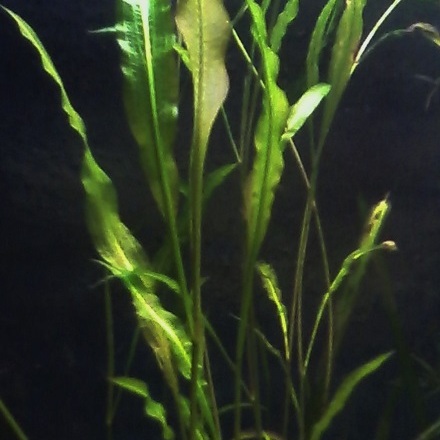Vertical shoot annual or biennial, seasonal; stem slender, terete, to 3 m long, mostly unbranched except at the end of the growing season; horizontal shoots slender to robust, long, creeping, much branched, forming dormant apical multiple rhizomatous tubers. Floating leaves, if present, lanceolate to ovate-lanceolate, petiolate, lamina 52-125 by 12-25 mm, 11-21-veined, base cuneate, apex acute, petioles 25-135 mm; intermediate leaves often present; petiolate; submerged leaves lanceolate, with parallel margins, petiolate, lamina 80-200(-310) by 7-20(-30) mm, 9-13-veined, margin dentate, at least around the tip, base cuneate, apex acute to acuminate, petioles 16-70(-140) mm; stipules axillary, convolute, 25-85 mm, whitish, persistent. Spikes cylindrical, contiguous, 25-56 mm; peduncles 46-70(-103) mm, slightly thicker than stem. Flowers numerous, with 4 carpels. Fruit 2-3.2 mm, with a ventral protrusion, sometimes with 1-3 dorsal keels. Stem anatomy: Stele of trio or proto type. Endodermis mostly of U-type, sometimes O-U-type or no thickening. Interlacunar bundles present, multicellular, in 1 or 2 rings, subepidermal bundles absent. Pseudo-hypodermis present, 1-layered. Chromosome number: 2n = 52.
More
Plants perennial, submerged. Rhizome terete, slender. Stems simple or rarely sparsely branched, internodes elongated, terete, ca. 2 mm in diam. Stipules axillary, convolute, large and conspicuous, 2.5-5 cm, membranous, free from leaf base. Submerged leaves petiolate; petiole 1.6-14 cm; blade narrowly oblong to oblong-lanceolate, 8-20(-31) × (0.7-)1.4-2(-2.7) cm, 9-13-veined, with a conspicuous midvein, base rounded or cuneate, margin undulate and minutely denticulate, apex mucronate. Floating leaves usually absent, sometimes present, bright green, often with reddish tinge, oblong to elliptic, 5.2-12.5 × 1.2-2.5 cm, 11-25-veined, base cuneate, apex mucronate. Spikes densely flowered, with many whorls of opposite flowers; peduncles 4-7 cm, thickened upward. Carpels 4. Fruit obovoid, 2-3.3 mm, abaxial keels 3, distinct, with a narrowly winglike midvein; beak short. Fl. and fr. Jun-Oct. 2n = 52.


